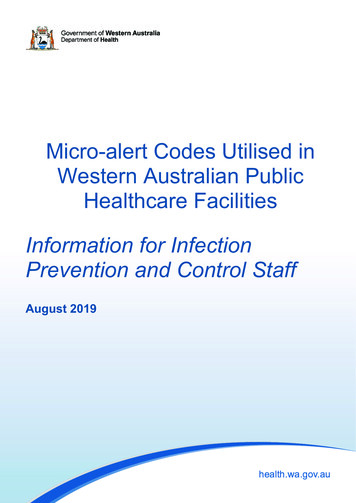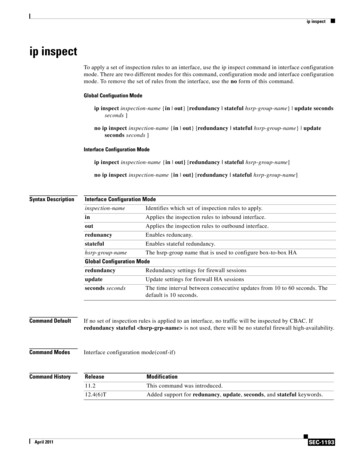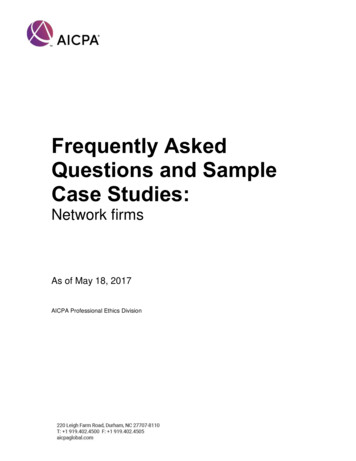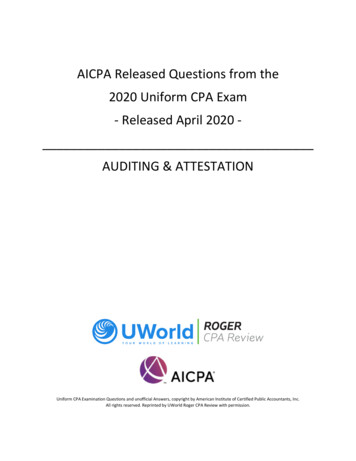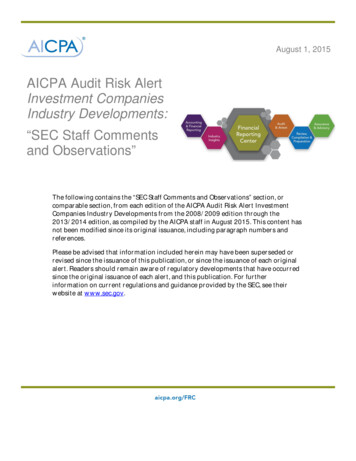
Transcription
August 1, 2015AICPA Audit Risk AlertInvestment CompaniesIndustry Developments:“SEC Staff Commentsand Observations”The following contains the “SEC Staff Comments and Observations” section, orcomparable section, from each edition of the AICPA Audit Risk Alert InvestmentCompanies Industry Developments from the 2008/2009 edition through the2013/2014 edition, as compiled by the AICPA staff in August 2015. This content hasnot been modified since its original issuance, including paragraph numbers andreferences.Please be advised that information included herein may have been superseded orrevised since the issuance of this publication, or since the issuance of each originalalert. Readers should remain aware of regulatory developments that have occurredsince the original issuance of each alert, and this publication. For furtherinformation on current regulations and guidance provided by the SEC, see theirwebsite at www.sec.gov.
AICPA Audit Risk AlertInvestment Companies IndustryDevelopments 2008/2009SEC Concerns.25Disclaimer: A summary of financial statement review comments issued by the SECstaff (the staff) to investment company registrants and other guidance related to issuesencountered by SEC registrants follows. These comments were compiled by the AICPAInvestment Companies Expert Panel and have not been approved or endorsed by the SEC orits staff. This is not intended to be a comprehensive list.Fund Marketing Materials.26The staff expressed concern about instances when fund marketing materials on theregistrant’s Web site are not consistent with information submitted in SEC filings, such asregistration or financial statements. In one instance, a closed-end fund had disclosed itsdistribution rate on its Web site without providing any explanatory context about itscomposition. This registrant had distributions that related to return of capital and capitalgains in the year disclosed. In another instance, a registered fund disclosed expense ratioson its Web site that were calculated based on methods that were not consistent with theinstructions provided in Form N-1A or Form N-2 (the forms) or generally acceptedaccounting principles (GAAP) requirements (for example, expense ratio was based onaverage total assets rather than average net assets or calculations excluded certainexpenses, such as interest expense). Registrants should ensure that marketing materials ontheir Web sites are consistent with information included in SEC filings and that financialinformation disclosed is consistent with the forms and GAAP.Disclosures of Credit Support in Financial Statements of Registered Money MarketFunds.27A number of publicly available no-action letters have been issued over the past yearrelating to support agreements provided to MMFs that experienced asset deterioration.These letters describe the obligation of an affiliate to guarantee payment of any scheduledprincipal and interest payments that are not made, including the principal and final interest
payment for a security or group of securities that a money market fund is holding. Theguarantee may be supported by the sponsor by obtaining a letter of credit from a highlyrated financial institution that has a credit rating comparable to other eligible moneymarket investments, if the sponsor itself does not have such a rating. Additionally, the termof the agreements typically is limited to the maximum term permitted (397 days) for aneligible nongovernment security under Rule 2a-7, “Money Market Funds,” under theInvestment Company Act of 1940. Under such arrangements, MMFs bear no costs relating tothe support agreements. The no-action letters can be accessed ml#chron.28Rule 2a-7 of the Investment Company Act of 1940 provides valuation guidance forregistered MMFs. The rule places certain investment restrictions on MMFs that wouldminimize the impact of valuation volatility of their underlying asset portfolios. Accordingly,MMFs generally invest in short term investments, including certificates of deposit,commercial paper, and government securities and pay dividends to shareholders thatgenerally reflect short-term interest rates. Although credit losses in the underlying portfolioof MMFs are possible, MMFs typically are managed with the goal of keeping losses to aminimum.29Some MMFs sought to increase yields by investing in highly rated, short term debttranches issued by structured investment vehicles (SIVs), which hold higher yieldingsecurities. During the past year, events in the credit markets created situations in which theshort term debt issued by certain SIVs could not be reissued due to concerns about some ofthe assets the SIVs held, causing buyers to be reluctant to purchase new paper. Additionally,in some cases, rating agencies downgraded SIV debt ratings due to asset concerns. Theimpact of these events left the SIVs in illiquid positions, and, in certain cases, the SIVsdefaulted on their short term debt, resulting in further reductions in the market values ofthe SIVs’ securities. In certain situations, market value decline became so significant that itpotentially could have resulted in MMFs’ noncompliance with Rule 2a-7 with respect tocertain portfolio securities. Such noncompliance would have required MMFs to convert thevaluation methodology followed for such portfolio securities from amortized cost to fairvalue, which would have caused the net asset value (NAV) per share to fluctuate from 1.00and most likely fall below 1.00. To prevent the NAV from falling below 1.00, certainsponsors or investment advisors of MMFs intervened and provided some level of financialsupport to MMFs. This support included, but was not necessarily limited to, capital
contributions, guarantees of value of specific investment securities (which may besupported through letters of credit), guarantees of principal of the overall funds, andagreements to purchase troubled securities at a value different than current market value(typically at amortized cost). The prospectuses of MMFs typically indicate that theshareholders in the MMFs are subject to the risk of loss of principal, and the sponsors oradvisors of the MMFs do not commit, by contract or otherwise, to financially support theMMFs prior to the occurrence of any valuation event. The decision to provide additionalfinancial support is made on a case-by-case basis when a specific MMF encounters difficulty.30As a result of the credit crisis, during the later part of 2007 and throughout 2008,the SEC’s Division of Investment Management staff received requests from MMF registrantsfor regulatory relief to the extent the MMFs’ sponsors or advisors were willing to enter intofinancial arrangements with MMFs that were encountering valuation difficulties. Inresponse, the SEC’s Division of Investment Management staff issued several no-actionletters. These no-action letters provided relief to certain MMFs and their sponsors oradvisors for situations in which the sponsors or advisors, at no cost to the MMFs, agreed toprovide support for the benefit of the MMFs. This relief occurred if specific MMFs’ securitiesor identified group of securities (“security subject to credit support agreement”) failed topay principal or interest as due or to the extent the MMFs would be forced to sell thesecurities at a value less than amortized cost. The SEC’s Division of Investment Managementstaff has required that credit support agreements, consistent with Rule 2a-7’s maturity andquality requirements, have a short lifespan and that the credit support agreement providerseither have a high credit standing or obtain a letter of credit from a financial institution witha high credit rating.31To the extent an MMF receives some type of support agreement similar to thosepreviously described, the MMF should present securities that are not subject to the creditsupport agreement(s) (and otherwise comply with the Rule 2a-7 guidelines) at amortizedcost. Because the credit support agreement is considered to be a derivative, both the creditsupport agreement and the securities covered by it should be presented at fair value withinthe financial statements. Registrants should indicate, within the schedule of investments,which securities are subject to the agreement and that such securities are being carried atfair value. The existence and value of the credit support agreement should be identifiedseparately on both the schedule of investments and the statement of assets and liabilities.Registrants also should refer to the note explaining the agreement.
.32For the MMFs that have credit support agreements, the SEC staff noted that the fairvalue of the credit support agreement should offset the decline in fair value of thosesecurities covered by the credit support agreement to ensure the MMF’s shadow pricedNAV does not fall below the minimum NAV specified in the credit support agreement. TheSEC staff indicated that they would expect to see, in plain English, the following disclosuresrelating to credit support agreements: Date of the agreement Entities that are parties to the agreement (including clear identification of anyaffiliated parties) Objectives of the agreement Triggering events for payments stipulated in the agreement (for example, sale ofthe security or determination by a court that full repayment will not occur) Terms of “backstop” provisions (that is, provisions requiring, upon maturity ofthe agreement, that the MMF sell or otherwise dispose of the securities involved,triggering payment under the agreement) Specific securities subject to the credit support agreement and their fair valueand amortized cost as of reporting date Date of termination of the credit support agreement Fair value of the credit support agreement at the reporting date Credit standing of the counterparty providing the credit support agreement (asnoted, the expectation is that this counterparty will have high credit standing) Disclosure on the schedule of investments of which securities are carried at fairvalue (that is, not at amortized cost) Disclosure on the schedule of investments of nonincome producing securitiesand securities that made partial principal or interest payments
Change in unrealized appreciation or depreciation for the securities subject tothe credit support agreement (to be presented in the statement of operations) Change in unrealized appreciation or depreciation on the credit supportagreement (to be presented as a separate line item on the statement ofoperations under the caption “change in unrealized appreciation(depreciation)from affiliates”) Realized gain or loss, if any, relating to the credit support agreement (to bepresented separately on the statement of operations).33Payments received and credit enhancements provided through the credit supportarrangements should be presented consistent with the guidance provided in chapter 7 ofthe 2008 AICPA Audit and Accounting Guide Investment Companies (2008 guide), includingdisclosure in the financial highlights of the effect on total return of the payment or creditenhancement.34The staff indicated that many of the disclosure requirements previously describedwere derived from FASB Statement No. 133, Accounting for Derivative Instruments andHedging Activities, and FASB Statement No. 57, Related Party Disclosures. The staff alsoindicated that these disclosures should be placed in a separate, readily identifiable, easy-tounderstand footnote to the financial statements and should not be placed within anothernote (such as a valuation policy or related party transactions note). MMFs should avoidcopying language directly from the credit support agreement into the notes to the financialstatements.35Finally, the staff described additional disclosures that should be considered when anMMF holds securities affected by the credit crisis, even if not covered by a supportagreement, no defaults exist, and NAV is not dramatically impaired: Disclosures about credit quality required by FASB Statement No. 107,Disclosures about Fair Value of Financial Instruments Disclosures relating to risk concentrations of investments in the real estate oraffected financial services industries (or in SIVs), as described in FASBStatement No. 107 and Statement of Position (SOP) 94-6, Disclosure of Certain
Significant Risks and Uncertainties (AICPA, Technical Practice Aids, ACC sec.10,640).36For more information, please refer to the AICPA Investment Companies ExpertPanel meeting highlights posted on the AICPA Web site atwww.aicpa.org/Professional Resources/Accounting and Auditing/Accounting Standards/expertpanel investco.htm.Questions Relative to FASB Statement No. 157 and Form N-Q Disclosures.37The staff has questioned instances when registered investment companies (RICs)excluded disclosures required by FASB Statement No. 157 from their Form N-Q, “QuarterlySchedule of Portfolio Holdings of Registered Management Investment Company,” filings.The staff noted that it was appropriate to include all disclosures required by FASBStatement No. 157 that are applicable to interim reporting periods, including the requiredroll-forward of assets and liabilities valued using unobservable, Level 3 inputs when aregistered investment company engages in a significant number of transactions in itemsvalued using Level 3 inputs or holds a significant number of Level 3-valued investmentsthroughout the reporting period. The staff indicated that Form N-Q refers to Rule 12b-20,“Additional Information,” of the Securities and Exchange Act of 1934, which states that aregistrant should include additional information to avoid making the schedule misleading.Seed Financial Statements and Recoupment Plan.38The staff noted that a closed-end fund recently restated its seed financial statementsbecause it failed to record a liability to the adviser under a recoupment plan. The staffstated that the note disclosure accompanying the seed financial statements indicated thatthe adviser will recoup organization costs after a specified period of time. Unlike traditionalrecoupment plans in which uncertainty exists about whether a fund’s net assets willincrease to a level that will permit repayment and not exceed a predefined expense cap, itwas probable that the adviser would recoup fees from the fund after a specified period oftime.Business Development Company Accounting for Income Tax Expense.39The SEC staff noted that a business development company (BDC) restated itsfinancial statements for improper accounting for income tax expense. Although the BDC
elected to qualify under Subchapter M of the IRC, the BDC accrued a deferred tax liabilityrelated to the unrealized appreciation of portfolio securities. The deferred tax liability hadbeen recorded by the BDC due to its perceived uncertainty surrounding the ability tomaintain its qualification. Chapter 6 paragraph .04 of the 2008 guide states, “Income taxexpense related to net investment income and net realized gains on investments should berecorded when it is probable that an investment company subject to Subchapter M of theIRC will not qualify under that subchapter. Management should consider the need forrecording a deferred tax expense if management concludes it is probable that theinvestment company will not meet its qualification requirements for a period longer thanone year.” The SEC staff questioned whether the BDC should have recorded a deferred taxliability given the BDC’s history of qualification under Subchapter M and its intent tocontinue to qualify under Subchapter M. The BDC ultimately concluded that the deferred taxliability was not appropriate and restated its financial statements to correct the error.40The staff further noted an instance when one open-end fund chose not to complywith Subchapter M of the IRC and, therefore, elected to be taxed as a corporation. However,this registrant did not accrue any deferred tax liabilities on the net unrealized appreciationof portfolio securities, as required under FASB Statement No. 109, Accounting for IncomeTaxes. The registrant made a correction by recognizing the deferred tax liabilities, inaccordance with FASB Statement No. 109.
AICPA Audit Risk AlertInvestment Companies IndustryDevelopments 2009/2010SEC Comments and ObservationsDisclaimer: The following comments represent the views of the accounting staff of theSEC’s Division of Investment Management and do not necessarily reflect the views of thecommission or other members on the commission’s staff. These comments werecompiled by the AICPA Investment Companies Expert Panel and have not been approvedor endorsed by the SEC or its staff. This is not intended to be a comprehensive list.Mergers and Liquidation.59The SEC staff has noted an increase in fund mergers and liquidations based on thefrequency of questions and N-14 filings received by the SEC staff. The staff expressedconcern that some registrants may be attempting to merge away funds with historicallypoor performance into funds with little or no performance history. Registrants arereminded to look to the 1994 North American Security Trust no-action letter for guidanceon evaluating which entity would be deemed the accounting survivor of the fund merger.The evaluation includes consideration of the investment adviser, fund size, fundcomposition, fund strategy, and expense arrangements, among other things. A registrantshould weigh all of these factors in order to conclude upon the accounting survivor.60Where differences in procedures and policies between funds participating in amerger exist (for example, valuation procedures and accounting policies) that will result inchanges affecting investors, disclosures in the proxy statements should detail the changesand how the changes will affect investors going forward. Subsequent financial statementdisclosures would only need to convey the current accounting policies and procedures ofthe surviving fund.61During fund mergers, most registrants look to utilize Rule 488 of the Securities Actof 1933, “Effective Date of Registration Statements Relating to Securities to Be Issued in
Certain Business Combination Transactions,” (Rule 488) which provides automaticeffectiveness to a registration statement filed on Form N-14 30 days after the date of suchfiling. Rule 488 requires the registration statement to be materially accurate and complete.A material omission of required financial information (for example, pro-forma financialstatements, audited financial statements, or auditor consents) would cause the registrationstatement not to qualify for 30 day automatic effectiveness under Rule 488.62The SEC staff reminded registrants that 11-02(b) of Regulation S-X, “Form andcontent,” permits registrants to provide a narrative description of the pro-forma effects ofthe merger instead of providing pro-forma financial statements, when there are a limitednumber of pro-forma adjustments and the pro-forma adjustments are easily understood.63The SEC staff also reminded registrants that when funds bear the costs associatedwith mergers, the pro-forma capitalization table should be adjusted to reflect the costs andthe statement of assets and liabilities should reflect the costs as a pro-forma adjustment.The statement of operations should not reflect these costs as a pro-forma adjustmentbecause such costs are nonrecurring.64The SEC staff provided guidance for the presentation of pro-forma fee tables andcapitalization tables in N-14 filings for registrants contemplating multiple mergers. Multiplemergers occur when three or more funds merge and the merger is not contingent uponshareholders of each fund approving the merger. In the pro-forma fee table, the SEC staffwould not object if registrants disclose a range of possible expense ratios, which wouldinclude the highest and lowest expense ratio and the expense ratio that would be incurred ifall funds merged. In the pro-forma capitalization table, the SEC staff would not object ifregistrants disclose the same combinations as disclosed in the pro-forma fee table or themost likely combination. The SEC staff also cited the 1995 “Dear CFO” letter, which allowsregistrants to present one set of pro-forma financial statements reflecting the combinationof all funds involved in the proposed merger.65Registrants should be aware of Article 3-18 of Regulation S-X, “Special Provisions asto Registered Management Investment Companies and Companies Required to BeRegistered as Management Investment Companies,” which requires financial statementsincluded in filings to be current (within 245 days of the effective date of the filing). If thedate of the financial statements exceeds 245 days of the effective filing date, the registrantneeds to include additional unaudited information.
Distressed Securities.66Management has the duty to look for and assess information relating to distressedsecurities. As such, management should have an appropriate process in place to monitor themarket, identify troubled securities, and react timely by taking appropriate write-downs orceasing interest accruals. Registrants should look to Article 12 of Regulation S-X, Form andContent of Schedules, for guidance on required disclosures relating to nonincome producingsecurities. For example, if the security has defaulted on interest payments, it should beflagged in the schedule of investments as a nonincome producing security. If there has beena partial interest payment, such information should also be flagged or disclosed by the fund.67Registrants can also look to the 1994 “Dear CFO” letter that provides guidance onhow a security should be disclosed in the schedule of investments when it has been writtendown to zero. A security should be removed from the schedule only after the fund hasidentified the security as worthless for federal income tax purposes. Omitting securitiesfrom the schedule prior to the determination of worthlessness for tax purposes may bemisleading to investors interested in evaluating the fund's investments.Securities Lending.68An area of increased SEC staff scrutiny is securities lending, specifically as it relatesto how the fair value of investments made with cash collateral received in connection withsecurities lending transactions were determined prior to the height of the credit crisis inSeptember 2008. Many registrants used cash collateral to purchase pooled investmentvehicles (PIVs) that were similar to Rule 2a-7 money market mutual funds, although thesefunds were not registered under the Investment Company Act of 1940. These pools typicallyheld investments with lower credit quality and longer maturities than permitted by Rule 2a7. As a result, the valuations of the securities in these investment pools were more volatilethan the valuations of securities held in money market funds complying with Rule 2a-7, andin some instances, the collateral pool’s NAV per share based on market values droppedbelow 1 per share. Addressing concerns about overall collateral pool liquidity, securitieslending agents continued to process shareholder transactions at 1 per share, but placedrestrictions regarding how investors would be redeemed out of these investment pools. Insome cases, funds requesting redemptions over certain thresholds or electing to withdrawfrom the securities lending program altogether, would be paid in-kind (that is, not in cash)in order to help regulate decreased pool liquidity levels. Some registrants, despite the
decrease in value and liquidity of the securities that made up the pool, continued to valuethese collateral pool investments at 1 per share until the fourth quarter of 2008. Given thatmany of these investment pools’ market values declined below 1 per share much earlierthan the fourth quarter of 2008, coupled with the redemption restrictions, the SEC staff isquestioning whether write-downs should have been taken prior to the fourth quarter of2008.69The SEC staff indicated that, in some cases, it was apparent that registrants did nothave appropriate policies and procedures in place to monitor the valuation of securities thatwere acquired with cash collateral received in conjunction with securities lendingtransactions. The SEC staff stated that registrants are responsible for the fair valuedetermination of cash collateral investments.70The SEC staff expressed concern over some disclosures they have seen in recentfilings. These disclosures were either unclear or lacking altogether. For example, the SECstaff noted that the disclosures in financial statements should convey whether losses haveactually been incurred during the reporting period rather than stating that losses may beincurred. Disclosures in the accounting policy footnotes for some funds mentioned thatinvestments of cash collateral received in connection with securities lending programs maydecline in value, when in fact the values did decline. If losses were incurred, it should beclearly communicated in the footnotes of the financial statements.Fulcrum Fees Under Rule 205-2(c) of the Investment Advisers Act of 1940.71The SEC staff has noted some advisers are switching to the use of fulcrum fees ascompensation for their advisory services provided to mutual funds. Fulcrum fees areperformance based fees in which advisers to mutual funds are compensated depending onhow well their managed fund performed relative to a particular benchmark. The fulcrum feeis made up of two components—the base fee (also referenced as the “fulcrum fee” in Rule205-2(c) of the Investment Advisers Act of 1940, “Definition of ‘specified period’ OverWhich the Asset Value of the Company or Fund under Management is Averaged”), whichrepresents the midpoint of the entire fulcrum fee, and the incentive adjustment. Generally,the adviser is paid the base fee if the fund’s performance matches the performance of thebenchmark. If the fund outperforms its benchmark, the adviser receives an incentivepayment in addition to the base fee. Conversely, if the fund underperforms its benchmark,the adviser is penalized and the base fee is reduced by a negative incentive adjustment.
When calculating payments to advisers under a fulcrum fee arrangement, the incentiveportion of the fee is required to be calculated using the average net assets over the rollingperformance measurement period. However, when calculating the base portion of thefulcrum fee, funds have the option to either apply the base rate to average net assets overthe rolling performance measurement period or apply the base rate to current level averagenet assets (or as Rule 205-2(c)(2) states, “asset value averaged over the most recentsubperiod,” - which represents the period between payments). Whichever option isapproved by the fund’s board, it must be applied consistently. In recent months, some fundsswitching to a fulcrum fee arrangement are opting to rely on Rule 205-2(c). Fulcrum feearrangements pursuant to Rule 205-2(c) may result in the adviser reimbursing the fund.This situation can occur when there is a significant decline in assets coupled with poorperformance because the negative performance adjustment, when translated from apercentage to dollars, exceeds the base fee. In this scenario, the base portion of the fee iscalculated on current level net assets that are much lower than average net assets over therolling performance measurement period. When funds rely on Rule 205-2(c)(2) to calculatethe base portion of the fulcrum fee, the SEC staff is reviewing the disclosure describing theterms of the advisory fee agreement and looking for specific disclosure stating that theadviser will reimburse the fund when the negative incentive adjustment exceeds the basefee.72In addition, the SEC staff has observed instances when advisers have attempted tolimit the incentive adjustment to a multiple of the base fee (for example, the incentiveadjustment cannot exceed two times the base fee). The SEC staff has objected to theseadjustments because it results in the incentive adjustment being tied to current level netassets rather than the average net assets over the rolling measurement period. Also, the SECstaff has objected to other fulcrum fee arrangements when the maximum negative incentiveadjustment was less than the maximum positive incentive adjustment.Expense Recapture Plans.73In an expense recapture plan, the adviser and the fund enter into an agreementwhereby the adviser can recapture expenses waived in prior years to the extent that thefund achieves economies of scale relevant to the established expense cap. The SEC staff hasseen instances where funds instituted a cap in the first year of operations and thenincreased the cap in subsequent years above the current expense ratio. The SEC staff
reminds registrants that they cannot begin to recapture prior year expenses incurred underprevious expense cap arrangements solely because of an increase in the current year’sexpense cap. Prior year expenses can be recaptured only if the current expense ratio is lessthan the prior year expense cap that was in place when such prior year expenses werewaived.Multiclass Presentation.74Most funds disclose the class-specific amounts for expenses and distributions on theface of the statement of operations or statement of changes in net assets, respectively. Dueto increases in the number of classes offered by some funds, the statements of operationsand changes in net assets can be cluttered. The SEC staff indicated that they would notobject if a fund presents aggregate amounts (for example, total 12b-1 fees or totaldistributions) in the financial statements and the class-specific amounts within theaccompanying notes to the financial statements.Financial Reporting.75The SEC staff has observed instances where counterparties to derivativeinstruments and interest rates on particular debt securities have not been identified in thefinancial statements. Registrants should look to Article 12 of Regulation S
comparable section, from each edition of the AICPA Audit Risk Alert Investment Companies Industry Developments from the 2008/2009 edition through the 2013/2014 edition, as compiled by the AICPA staff in August 2015. . Fair value of the credit support agreement at the reporting date Credit standing of the counterparty providing the credit .


